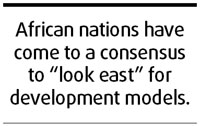It has been said that India's decision to hold this African summit was inspired by the China-Africa Summit of 2006. Indeed it is not hard at all to see the link between the two summits. The Indian academic community and the media have made no efforts to deny the link.

Some Indian and other media organizations made no bones about comparing the New Delhi summit to the one held in Beijing two years ago. Quite a few foreign media channels gave prominence to the view that India is competing against China to influence Africa, stepping up efforts to corner more African resources and market before China does, and so on.
There is no denying that fast economic growth of both the Asian giants and their growing influence in Africa gave rise to comparative studies on the development patterns of the "Chinese dragon" and the "Indian elephant" and on their impact on Africa's development.
The Organization of Economic Cooperation and Development published a study in May, 2006, titled The Rise of China and India: What's in it for Africa. The World Bank followed with a similar report - Africa's Silk Road: China and India's new economic frontier - the next year.
Both papers are considered authoritative and professional. And they both agreed the rise of Chinese and Indian economies is having a positive impact on Africa's development. They argued that the fast economic development of China and India is boosting that of Africa much quicker than most people expected and has helped Africa maintain unprecedented and close contacts with the world economy through exports of resources and raw material.
Of course, apart from numerous analyses and commentaries, there have been painstaking efforts by ill-meaning people who see things through tinted glasses to play up China-India rivalries and conflicts as well. Such writings invariably try to sow distrust between the two Asian neighbors by flattering India, while belittling China.
Some Indian observers pointed out publicly that such mentality is born of a desperation prompted by the fast-approaching end of Western colonial influence in Africa as well as by the fear of and objection to the reality that rising nations such as China and India are changing the world order Western powers prefer. And, by sowing discord between China and India, the detractors wish to see the two Asian neighbors fight till they are both too hurt to react when the West takes control of Africa.
As a matter of fact, it is not important to know which summit inspired the other. What is important is the fact that emerging Asian economies such as China and India and Africa's rising economic potential and international clout have been drawing the two developing continents closer in the past 10 years or so. We should hail the coming tide of Asia-Africa cooperation, because it is fueling what we call South-South cooperation and contributing to the international cooperation that will help Africa attain the United Nations' Millennium Development Goals.
Africa has been drawing the world's attention in the past decade as the situation on the continent gradually improved and its resources and market potential showed growing significance. Take a closer look and one will see that the "Africa fever" was not the result of its own rising status alone but of increased cooperation with emerging Asian economies and its "look-east" policy as well.
Since the end of the colonial era in the 1960s, Africa has largely remained a supplier of raw material for developed Western countries, while Western nations' aid for Africa has failed to lift the continent out of poverty and backwardness.
That is why African nations have come to the consensus to "look east" for development models in Asia.
African countries seem to identify with India's development pattern, which combines democracy organically with its developing country status - very different from the patterns in Western nations. African nations are also interested in India's experience in handling conflicts between castes and clans and preventing the gap between rich and poor from worsening.
The eastward movement of African countries not only helps them learn from Asian countries' advanced experiences but also raises their stakes in South-North talks and negotiations. Such engagements should help them protect their natural resources, while developing the economy, emphasize environmental protection.
Thus, when we look at the India-Africa Summit, which has been billed as "India's top event in foreign affairs", it is necessary to recognize the relationship of mutual example and certain amount of competition between China and India in their cooperation with African nations. Even more important is that we need to see from a broad human development point of view the mutually-complementary nature of the two Asian giants' assistance to African development and Africa's absorption of different "nutrients" from Chinese and Indian development patterns.
The roles that China and India play to strengthen Asia-Africa unity and South-South cooperation are of historic significance. There is no reason why the world's top two developing nations, with matching populations, cannot play joint catalysts in taking Asia-Africa cooperation into a new era.
The author is a researcher with the Institute of West Asian and African Studies of the Chinese Academy of Social Sciences

No comments:
Post a Comment